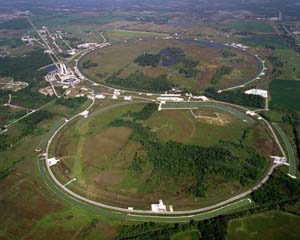High-energy instruments to reveal a new world
 | 
The Main Injector Ring (front) and the 4-mile-long Tevatron dominate the aerial view of Fermilab. |
Physicists use high-energy accelerators to probe matter at the smallest scale. More powerful than any microscope, a high-energy accelerator allows physicists to study the smallest things human beings have ever seen, for example the quarks inside a proton. At the same time, high-energy accelerators can recreate the conditions of the early universe – though in a much smaller volume. Creating tiny fireballs of high density and high temperature, physicists produce the particles that were abundant in the early universe, a trillionth of a second after the Big Bang.
Fermilab's Tevatron was the second-most powerful accelerator in the world. In 1995, the
high-energy collisions of the Tevatron led to the discovery of the top quark, the heaviest elementary particle known to exist. The top quark is as heavy as a gold atom, yet its mass is confined to an area much smaller than a single proton.
The Tevatron accelerated and collided protons and antiprotons in a four-mile-long underground ring. Fermilab scientists used a chain of accelerators to produce and accelerate these particles before injecting them into the Tevatron ring.
About 2,300 physicists from all over the world still come to Fermilab to conduct experiments using particle accelerators. To observe and record the high-energy collisions from the Tevatron, physicists had built enormous detectors. Today they continue to use powerful computers to sort through and analyze the enormous amount of data they collected from accelerator experiments. They study the properties of and forces among particles to test and develop theoretical models to explain matter, space and time, the fundamental structure of our universe.
|



